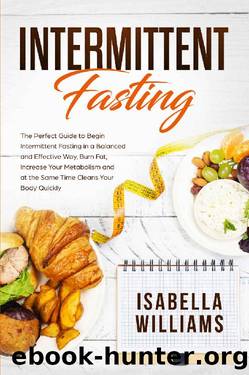Intermittent Fasting: The Perfect Guide to Begin Intermittent Fasting in a Balanced and Effective Way, Burn Fat, Increase Your Metabolism and at the Same Time Cleans Your Body Quickly. by Isabella Williams

Author:Isabella Williams [Williams, Isabella]
Language: eng
Format: epub
Published: 2020-02-18T18:30:00+00:00
Day 2:
Try Delaying Breakfast
8.00 a.m.: Congratulations! You succeeded in fasting for 12 hours. Since you're just starting it might be a good idea to start small first before increasing your fasting window and reducing the feeding one.
Your last meal was around 8 pm the previous night, and now it is 8 am; that's precisely 12 hours of fasting. You abstained from eating for half a day. You were able to balance fasting and eating to a ratio of 50:50. It's a good thing for a first-timer. You ate for 12 hours and fasted for the remaining 12.
If you take the time to analyze your progress, you’ll find out that it wasn’t so bad – after all you were asleep for most of it. It’s normal for time to fly when you’re sleeping.
It is morning now, and you probably need to rush off to work or you’ll be late. You might not even have enough time to eat anything before leaving. Better still, grab what you’ll eat later at the office but don’t eat until much later. Try to delay your breakfast as long as possible. In the meantime just try holding yourself with water, tea, or black coffee.
It’s not extreme or unusual to delay your first food of the day until it’s convenient for you. Once you arrive at work, settle down and take stock of your environment. Go through your calendar, email, Facebook, day-planner, etc. Take your time.
10.00 a.m.: Now that you've waited up to this point, it's time to have your breakfast since everything around you has been settled. By now you've fasted for 14 hours. Select something healthy and wholesome – preferably with fruit to accompany the meal.
Noon: While this might be the approved lunchtime for most people, it doesn’t have to be for you. Besides, you might not be hungry by now, having just eaten not too long ago. The clock might be saying it’s time for lunch, but your body feels otherwise. It’s okay to wait a little longer until you feel hungry to eat again. There’s no rule that said you must eat at a particular time.
2.00 p.m.: By now you might be feeling hungry again since you haven't eaten anything since 10 am. Go get something from the café across from you. Or if you packed lunch for yourself, you could always eat that.
7.00 p.m.: You’ve been home from work for a while now and haven’t eaten anything yet. Go to your fridge and prepare something to eat. Remember that you need to stop eating as soon as it is 8 p.m.
Try building on the steps you took today for subsequent days. Don't eat anything after dinner, and delay eating breakfast until it's at about 10 am or so. The key to succeeding at intermittent fasting is following a routine of sorts.
Download
This site does not store any files on its server. We only index and link to content provided by other sites. Please contact the content providers to delete copyright contents if any and email us, we'll remove relevant links or contents immediately.
The Bone Broth Miracle: How an Ancient Remedy Can Improve Health, Fight Aging, and Boost Beauty by Ariane Resnick(16127)
How to Be a Bawse: A Guide to Conquering Life by Lilly Singh(6686)
The Fat Loss Plan by Joe Wicks(4231)
The Ultimate Bodybuilding Cookbook by Kendall Lou Schmidt(3309)
A Jewish Baker's Pastry Secrets: Recipes from a New York Baking Legend for Strudel, Stollen, Danishes, Puff Pastry, and More by George Greenstein(3100)
The French Women Don't Get Fat Cookbook by Mireille Guiliano(2975)
Better Homes and Gardens New Cookbook by Better Homes & Gardens(2948)
Super Food Family Classics by Jamie Oliver(2905)
Tom Kerridge's Dopamine Diet: My low-carb, stay-happy way to lose weight by Kerridge Tom(2674)
Dinner in an Instant by Melissa Clark(2660)
Bread Revolution by Peter Reinhart(2634)
Body Love by Kelly LeVeque(2626)
Tone Your Tummy Type by Denise Austin(2364)
Ottolenghi - The Cookbook by Yotam Ottolenghi(2352)
Flavor Flours by Alice Medrich(2335)
The Fat Chance Cookbook by Robert H. Lustig(2316)
LL Cool J's Platinum 360 Diet and Lifestyle by LL Cool J(2310)
Oh She Glows Every Day by Angela Liddon(2305)
The Kitchen Counter Cooking School by Kathleen Flinn(2009)
